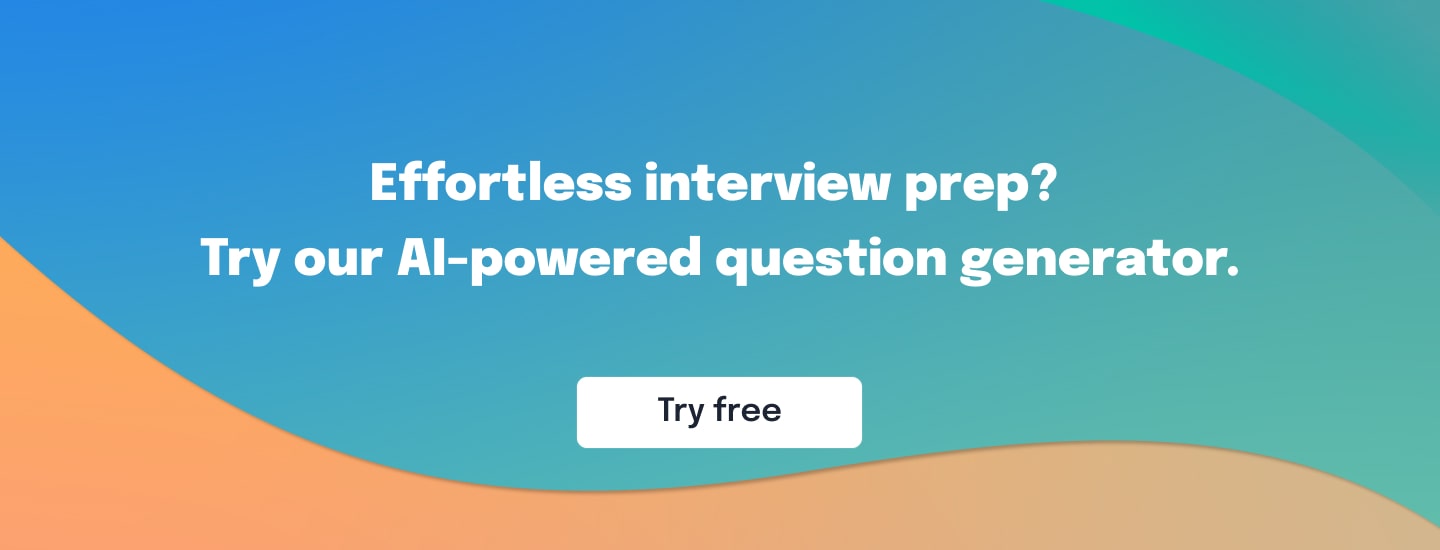Welcome to ourguide on interviewing Senior JavaScript developers. Drawing from our experience of hundreds of developer interviews held alongside our clients, we understand that finding the right candidate isn’t just about skills; it’s about discovering individuals who align with your company’s values and vision. It is true no matter whether you’re hiring an in-house employee or a contractor developer.
Navigating the landscape of JavaScript development requires a keen understanding of various facets, from core concepts to framework expertise, security measures, and user experience optimization.
In our quest for the best candidates, we’ve learned that interviews are crucial for uncovering a developer’s true potential. By using insights from our day-to-day work in ensuring the best match between clients’ requests and developers’ skills and personalities, we’ve put together a set of questions and follow-ups that go beyond the surface. These questions are tailored to help you assess practical abilities and decision-making skills.
Table of Contents
1: Can you explain the concept of closures in JavaScript and provide an example of how they can be useful?
Expected Answer: Closures are functions that remember the lexical scope in which they were created. An example could be a function within another function that retains access to its parent’s variables. This is crucial for maintaining data privacy and creating modular code.
Explanation: This question evaluates the candidate’s understanding of closures, a powerful and often misunderstood aspect of JavaScript. An adept knowledge of closures signifies their ability to write efficient and maintainable code.
1.1: How can closures be leveraged to mitigate the effects of the “callback hell” and improve the readability of asynchronous JavaScript code?
Expected Answer: By using closures, we can encapsulate asynchronous operations within named functions, making code more structured and readable. This aids in avoiding callback hell and simplifying error handling.
Explanation: This question assesses the candidate’s practical understanding of how closures can enhance code organization and readability, especially in asynchronous scenarios.
1.2: Can you discuss potential memory-related issues that might arise when using closures, and how can they be mitigated?
Expected Answer: Closures can lead to memory leaks if not handled properly, as they retain references to variables even after they’re no longer needed. Implementing proper cleanup strategies, such as removing event listeners, can help prevent memory leaks.
Explanation: Understanding memory management in closures showcases the candidate’s awareness of potential pitfalls and their ability to write code that avoids memory-related problems.
2: Have you worked extensively with any modern JavaScript frameworks like React, Angular, or Vue.js? Can you discuss your experience with one of them?
Expected Answer: Yes, I’ve worked extensively with React. It’s a declarative library for building user interfaces, allowing the creation of reusable UI components that update efficiently.
Explanation: This question explores the candidate’s familiarity with popular JavaScript frameworks, which are essential for building modern, dynamic web applications.
2.1: In your experience with React (or any other framework), can you explain the concept of virtual DOM and how it improves the efficiency of UI updates?
Expected Answer: The virtual DOM is a lightweight representation of the actual DOM. React uses it to efficiently update only the necessary parts of the UI, minimizing performance bottlenecks caused by direct manipulation of the DOM.
Explanation: Knowledge of virtual DOM demonstrates the candidate’s grasp of performance optimization techniques in modern front-end development.
2.2: Could you discuss your approach to managing state in a complex React application and maintaining a consistent flow of data between components?
Expected Answer: In React, I use state management libraries like Redux or React’s Context API to manage the global state and ensure a smooth flow of data between components.
Explanation: This question evaluates the candidate’s expertise in state management, a critical aspect of building maintainable and scalable front-end applications.
3: How do you handle asynchronous operations in JavaScript, and what are the advantages of using promises or async/await?
Expected Answer: I use promises or async/await to handle asynchronous operations. Promises provide better readability and error handling, while async/await simplifies the syntax and makes code more sequential.
Explanation: This question assesses the candidate’s knowledge of handling asynchronous operations, a fundamental skill in modern JavaScript development.
3.1: Can you discuss the potential pitfalls of chaining too many promises or using excessive nested async/await statements, and how would you address them?
Expected Answer: Chaining too many promises can lead to callback hell, making code hard to read. To address this, I use techniques like Promise.all() to parallelize operations and keep the codebase clean.
Explanation: Understanding promise chaining and async/await helps the candidate write code that is both efficient and maintainable, avoiding issues like callback hell.
3.2: How would you handle errors in asynchronous code, and can you provide an example of using try/catch blocks with async/await?
Expected Answer: I handle errors by wrapping asynchronous code in try/catch blocks. For instance, when fetching data from an API using async/await, I catch potential errors and handle them.
Explanation: Proficiency in error handling in asynchronous operations ensures the candidate can write robust and reliable JavaScript code.
4: Can you discuss your experience with optimizing frontend performance in JavaScript applications?
Expected Answer: I’ve optimized frontend performance by techniques like code splitting, lazy loading, and minimizing network requests. These strategies improve initial loading times and overall user experience.
Explanation: This question evaluates the candidate’s awareness of performance optimization techniques, vital for delivering fast and efficient user interfaces.
4.1: How do you approach reducing the time to interactive (TTI) in a JavaScript application, and can you provide an example of a project where you successfully improved TTI?
Expected Answer: To reduce TTI, I prioritize critical rendering paths, defer non-essential scripts, and use asynchronous loading. In a project, I improved TTI by optimizing image loading and implementing lazy loading for off-screen content.
Explanation: Knowledge of strategies to enhance TTI demonstrates the candidate’s ability to create highly responsive web applications.
4.2: What tools or techniques have you used to identify performance bottlenecks in JavaScript applications, and how did you address them?
Expected Answer: I’ve used browser developer tools, lighthouse audits, and tools like WebPageTest to pinpoint bottlenecks. I addressed them by optimizing rendering, reducing unnecessary reflows, and implementing caching mechanisms.
Explanation: Understanding how to identify and address performance bottlenecks is essential for maintaining fast and efficient applications.
5: Have you worked with server-side rendering (SSR) or client-side rendering (CSR) in JavaScript applications? Can you discuss the advantages and disadvantages of each approach?
Expected Answer: Yes, I’ve worked with both SSR and CSR. SSR improves initial load times and SEO, while CSR offers more dynamic user experiences. The choice depends on project requirements.
Explanation: This question examines the candidate’s familiarity with rendering approaches, crucial for making informed decisions in frontend architecture.
5.1: In your experience, how do you strike a balance between SSR and CSR to achieve optimal performance and user experience?
Expected Answer: I use SSR for critical content and CSR for interactive components. This combination ensures quick initial loading and maintains a responsive interface for subsequent interactions.
Explanation: Understanding when to apply each rendering approach demonstrates the candidate’s ability to create efficient and user-friendly web applications.
5.2: Can you discuss any challenges you’ve encountered when implementing SSR, and how did you address them?
Expected Answer: Implementing SSR can be complex due to server-client synchronization. Challenges include data fetching and handling client-side interactions. I tackled them by using libraries like Next.js, which simplify SSR implementation.
Explanation: Acknowledging and overcoming challenges in implementing SSR illustrates the candidate’s practical expertise in frontend architecture.
6: How do you ensure code maintainability and modularity in large JavaScript codebases?
Expected Answer: I follow modular design principles, use component-based architectures, and apply naming conventions to ensure code organization. This promotes reusability and maintainability.
Explanation: This question evaluates the candidate’s approach to writing maintainable code, essential for long-term project success.
6.1: Can you discuss your experience with using design patterns like MVC or MVVM in JavaScript applications, and how they contribute to code organization?
Expected Answer: I’ve used MVC (Model-View-Controller) and MVVM (Model-View-ViewModel) patterns. They separate concerns and facilitate code organization, making it easier to manage complexity in large codebases.
Explanation: Familiarity with design patterns signifies the candidate’s ability to structure code in a way that enhances maintainability and scalability.
6.2: How do you ensure consistent coding standards and best practices are followed by your team in a collaborative JavaScript project?
Expected Answer: I advocate for code reviews, use linters and formatters, and establish coding guidelines. Regular discussions on best practices ensure code quality is upheld throughout the development process.
Explanation: This question explores the candidate’s leadership skills and their ability to maintain code consistency within a collaborative environment.
7: Could you discuss your experience with working in an Agile or Scrum development environment for JavaScript projects?
Expected Answer: I’ve worked extensively in Agile environments, using Scrum to deliver iterative and incremental releases. This approach enhances collaboration, adapts to changes, and ensures frequent deliverables.
Explanation: This question assesses the candidate’s familiarity with Agile methodologies, crucial for effective collaboration and project management.
7.1: How do you ensure that development tasks in an Agile environment are well-defined, estimated accurately, and completed within the designated sprint time?
Expected Answer: I collaborate closely with the team and follow user stories or tasks defined in the sprint backlog. Estimations are based on historical data, and regular communication helps ensure tasks are completed on time.
Explanation: The ability to manage tasks effectively within an Agile framework highlights the candidate’s project management skills.
7.2: Can you discuss any challenges you’ve encountered while implementing Agile practices in JavaScript projects, and how you resolved them?
Expected Answer: Challenges include handling changing requirements and maintaining consistent sprint velocity. We resolved them through clear communication, regular retrospectives, and flexibility in adapting to changes.
Explanation: Overcoming challenges in Agile implementation demonstrates the candidate’s adaptability and problem-solving abilities.
8: How do you approach cross-browser compatibility and ensure consistent user experiences in JavaScript applications?
Expected Answer: I use feature detection, progressive enhancement, and testing tools like BrowserStack to identify and address compatibility issues. This approach ensures a consistent experience across different browsers.
Explanation: This question evaluates the candidate’s approach to creating web applications that function seamlessly across various browsers, critical for user satisfaction.
8.1: Can you discuss a specific example of a cross-browser compatibility issue you encountered and how you resolved it?
Expected Answer: I faced an issue with CSS flexbox not rendering correctly in Chrome. I resolved it by applying fallback styles and using CSS grid as an alternative layout method.
Explanation: Sharing specific experiences showcases the candidate’s problem-solving skills in handling real-world compatibility challenges.
8.2: How do you keep up with the evolving landscape of JavaScript frameworks and libraries, and how do you decide when to adopt new technologies in your projects?
Expected Answer: I regularly read blogs, attend conferences, and follow community discussions. I adopt new technologies when they align with project requirements, offer substantial benefits, and have proven stability.
Explanation: Staying updated with JavaScript trends and making informed technology adoption decisions is crucial for maintaining up-to-date and efficient projects.
9: Have you worked on integrating third-party APIs or services in JavaScript applications? Can you discuss a project where you successfully integrated an API?
Expected Answer: Yes, I’ve integrated APIs like Google Maps API for location services. In a project, I integrated a payment gateway API to enable secure transactions within the application.
Explanation: This question assesses the candidate’s experience in connecting applications with external services, a common task in modern web development.
9.1: How do you handle potential issues like rate limiting, authentication, and error handling when integrating third-party APIs?
Expected Answer: I use proper authentication mechanisms, monitor API usage to avoid rate limits, and implement error handling to gracefully handle unexpected responses.
Explanation: Addressing challenges in API integration demonstrates the candidate’s knowledge of best practices in handling external service interactions.
9.2: Can you discuss the benefits of using asynchronous techniques like promises or async/await when making API requests in JavaScript applications?
Expected Answer: Asynchronous techniques prevent blocking the main thread, ensuring smooth user experiences. Promises or async/await simplify handling asynchronous operations, making code more readable and maintainable.
Explanation: Understanding the advantages of asynchronous techniques showcases the candidate’s ability to write efficient and responsive code in web applications.
10: Can you discuss your experience with optimizing and securing JavaScript applications to prevent common vulnerabilities like Cross-Site Scripting (XSS) or Cross-Site Request Forgery (CSRF)?
Expected Answer: I’ve optimized and secured applications using techniques like input validation, escaping user input, and implementing security headers. I’m also familiar with Content Security Policy (CSP) to mitigate potential threats.
Explanation: This question evaluates the candidate’s awareness of security best practices in web development, crucial for protecting applications from common vulnerabilities.
10.1: How would you handle a potential XSS attack in a JavaScript application, and what steps would you take to prevent such attacks in the first place?
Expected Answer: I’d sanitize and validate user inputs, escape output to prevent script execution, and implement a robust Content Security Policy. Preventative measures include input validation and output encoding.
Explanation: Understanding how to both prevent and mitigate security vulnerabilities showcases the candidate’s commitment to writing secure code.
10.2: Can you discuss any challenges you’ve encountered while securing JavaScript applications, and how did you address them?
Expected Answer: Challenges include finding the right balance between security and functionality. I addressed them by conducting thorough security audits, staying updated with security news, and collaborating with security experts.
Explanation: Overcoming security challenges requires a proactive approach, and sharing experiences demonstrates the candidate’s practical expertise in secure coding practices.
Questions asked by our clients during interviews with JavaScript developers
- Give me an overview of your tech stack and your skill set. What are you comfortable with? What would you say are your strengths or weaknesses?
- Have you been working with infrastructure as code? Did you prepare an infrastructure for projects from scratch?
- Did you implement a serverless framework ECS?
- Why did you decide to use ECS and containers instead of just using an easy choice?
- Do you have any experience with PostgreSQL? Would you tell me a little bit about the pros and cons of using a relational database versus using a non-relational database?
- How do you handle the structure of a relational database and a non-relational database in your projects?
- In which way did you implement GraphQL in your previous projects? What kind of libraries or tools did you use? How did you create the schema of your graph?
Final thoughts
In conclusion, interviewing Senior JavaScript developers is a journey of uncovering potential and fit within your team. These thoughtfully crafted questions go beyond the conventional, providing insights into a candidate’s skills, problem-solving acumen, and adaptability. With each inquiry, you’ll gain a deeper understanding of their practical experience and decision-making capabilities.
Remember that while technical expertise is crucial, finding a developer who aligns with your company’s culture and goals is equally important. To streamline and customize your developer vetting process, consider leveraging i1, an AI assistant specialized in vetting talent. With its deep learning capabilities, i1 helps you create a custom interview process based on your company’s unique standards and values.
Consider all this to empower you to make well-informed hiring decisions and find the Senior JavaScript developer who not only meets your technical requirements but also enriches your team’s dynamic and innovative spirit. Happy hiring!





